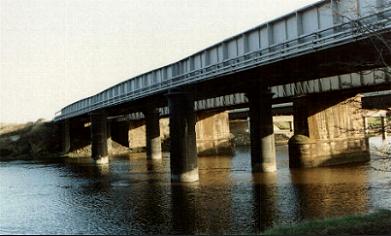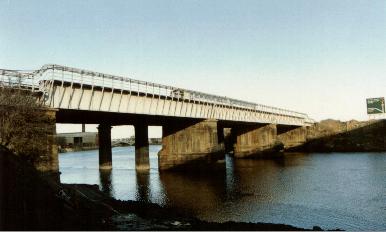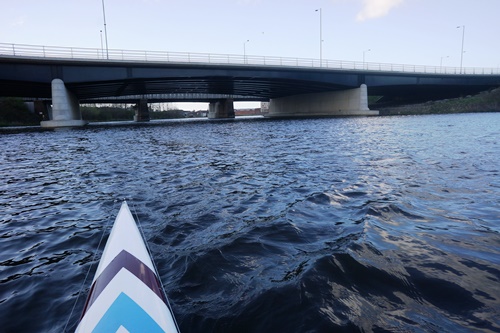


At the upstream end of Boathouse Reach we have a group of three bridges – two rail and one road.
Rowing boats should use the central arch of each bridge for downstream passage. Upstream traffic should keep close to the Stockton side of the river by the old boathouse and pass through the right hand arch of the railway bridges and then the central arch of the road bridge but keep a good lookout not only for oncoming boats but also for debris in the water. Other river traffic might use the central arch for upstream travel so be prepared.
Note that visibility in both directions is somewhat obstructed by the bridge piers. Care and skill are needed to ensure that you are in the correct position through the arches ie to the right of the central channel. You must keep checking to see if any craft are coming in the opposite direction as they may appear suddenly having been hidden by a blind spot. Coming downstream (1)- you need to look out for boats coming upstream. (2)- If doing a timed piece to the A66 make sure you wind down in time to be able to stop if necessary. (3)- immediately you are clear of the bridges you need to make a definite turn to starboard (right) in order to maintain your correct station “on the right”.
Going upstream remember that crews/scullers may be coming down having just finished “doing a piece”. They will be tired and, despite the advice given above, may not be fully alert. “If in doubt, shout!” Watermanship includes use of all the senses, not just sight. Listen for warning shouts from other boats and if in doubt shout a warning yourself. Listen also for the siren of the Teesside Princess – it is quite distinctive and nothing like that of a railway engine! Remember too that wind can affect your course – particularly through bridges.
Although information on all the other Tees Bridges is available in some detail, this railway bridge has proved to be the exception. It would appear that some time late in the 19th century extra rail line capacity was needed across the river. At the same time Stephenson’s Bridge had some structural problems which meant that it was subject to a weight restriction. So the railway company rapidly built this additional bridge alongside. It comprises spans in plate steel set on cast iron piers which are filled with concrete. Some time ago it became redundant and the rail tracks tracks were taken up.
In December 1830 an extension to the Stockton and Darlington Railway was opened to enable coal from Co.Durham to be shipped out of Port Darlington. Known as the Middlesbrough Branch it crossed the Tees via a suspension bridge – the first railway bridge of this type in the world. It’s designer was Samuel Brown – a Captain in the Royal Navy, a profession not exactly renowned for bridge design and construction. It was a failure, bouncing and wobbling when trains passed over it. The great Isambard Kingdom Brunel commented “Wretched thing…..the floor creaks most woefully in returning”. George Stephenson was a little more forthright describing it as “a complete failure”. In 1841 Stephenson designed a cast iron girder bridge with masonary piers to replace it. Ironically this bridge also encountered structural problems and was subsequently shored up and subjected to a weight restriction. After the second bridge was built the opportunity was taken to carry out more permanent improvements to Stephenson’s bridge. In 1907 the cast iron spans, which were structurally suspect, were replaced with steel. So well specified and constructed were the stone piers and the foundations that they were retained. The piers through which we pass today, and which you can see in this photo, are therefore those put in place 160 years ago.
Built in 1982 by Cementation Construction the Surtees Bridge carries the A66 trunk road over the River Tees thus completing the dual carriageway link between Darlington and Middlesbrough. At the same time it enables traffic to by pass Stockton and to “underpass” Thornaby. It mirrors the railway bridges in having five spans and aligned piers. The spans are in a special type of steel known as “Corten”. This material includes copper and was specifically developed to improve weathering qualities. A protective layer forms on the surface which prevents further oxidisation. Protective painting is therefore unnecessary.(The rods supporting the Teesquay Millenium Bridge are of the same material). The piers are of concrete. I am given to believe that plans have been made to widen the bridge to three lanes each side although so far little publicity seems to have been given to such a scheme. As for the origin of the name I am at present unsure. The Surtees family are long established in the north east of England and it is probable that the bridge is named after Robert Surtees of Mainsforth Hall (1779 – 1834) whose “The History and Antiquities of the County Palatine of Durham -a pre industrial history of the County” is regarded as the definitive work. To this day the Surtees Society continues his work through publication of historical manuscripts of Northumberland, Durham and the North Riding of Yorkshire.